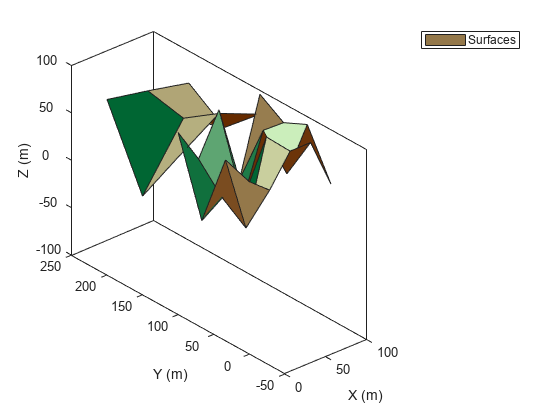plotSurface
Description
Examples
Create a radar scenario.
scenario = radarScenario;
Define the terrain and boundaries of two surfaces and add the two surfaces to the radar scenario.
terrain1 = randi(100,4,5);
terrain2 = randi(100,3,3);
boundary1 = [0 100;
0 100-eps];
boundary2 = [0 100;
100 200];
s1 = landSurface(scenario,Terrain=terrain1,Boundary=boundary1);
s2 = landSurface(scenario,Terrain=terrain2,Boundary=boundary2);Obtain the plotter data by using the surfacePlotterData function.
plotterData = surfacePlotterData(scenario.SurfaceManager)
plotterData=1×2 struct array with fields:
X
Y
Z
C
Create a theaterPlot object and specify the axis limits of the plot.
theaterpplot = theaterPlot(XLimits=[0 100],YLimits=[-50 250],ZLimits=[-100 100]);
Create a surface plotter.
plotter = surfacePlotter(theaterpplot,DisplayName="Surfaces");Plot surfaces in the theater plot. Change view angles for better visualization.
plotSurface(plotter,plotterData) view(-41,29)

Input Arguments
Surface plotter object, created by the surfacePlotter function.
Plot data, specified as an S-element array of structures, where
S is the number of surfaces. You can directly create this argument
by using the surfacePlotterData function. To create this argument manually, specify
each structure with these fields.
| Field Name | Description |
|---|---|
X | Domain of the surface in the x-direction, specified as an M-element real-valued vector. M is the number of x-coordinates for defining the terrain of the surface. The values for the elements in the vector must monotonically increase. |
Y | Domain of the surface in the y-direction, specified as an N-element real-valued vector. N is the number of y-coordinates for defining the terrain of the surface. The values for the elements in the vector must monotonically increase. |
Z | Height values of the surface, specified as an
N-by-M real-valued matrix.
N is the number of elements in the Y
field, and M is the number of elements in the
X field. |
C | Color for vertices in the terrain of the surface, specified as an
N-by-M-by-3 matrix of RGB triplets.
N is the number of elements in the Y
field, and M is the number of elements in the
X field. The plotSurface function
determines the color of a surface patch based on the color of its first
vertex. |
Version History
Introduced in R2022b
See Also
surfacePlotterData | surfacePlotter | theaterPlot | SurfaceManager
MATLAB Command
You clicked a link that corresponds to this MATLAB command:
Run the command by entering it in the MATLAB Command Window. Web browsers do not support MATLAB commands.
Select a Web Site
Choose a web site to get translated content where available and see local events and offers. Based on your location, we recommend that you select: .
You can also select a web site from the following list
How to Get Best Site Performance
Select the China site (in Chinese or English) for best site performance. Other MathWorks country sites are not optimized for visits from your location.
Americas
- América Latina (Español)
- Canada (English)
- United States (English)
Europe
- Belgium (English)
- Denmark (English)
- Deutschland (Deutsch)
- España (Español)
- Finland (English)
- France (Français)
- Ireland (English)
- Italia (Italiano)
- Luxembourg (English)
- Netherlands (English)
- Norway (English)
- Österreich (Deutsch)
- Portugal (English)
- Sweden (English)
- Switzerland
- United Kingdom (English)